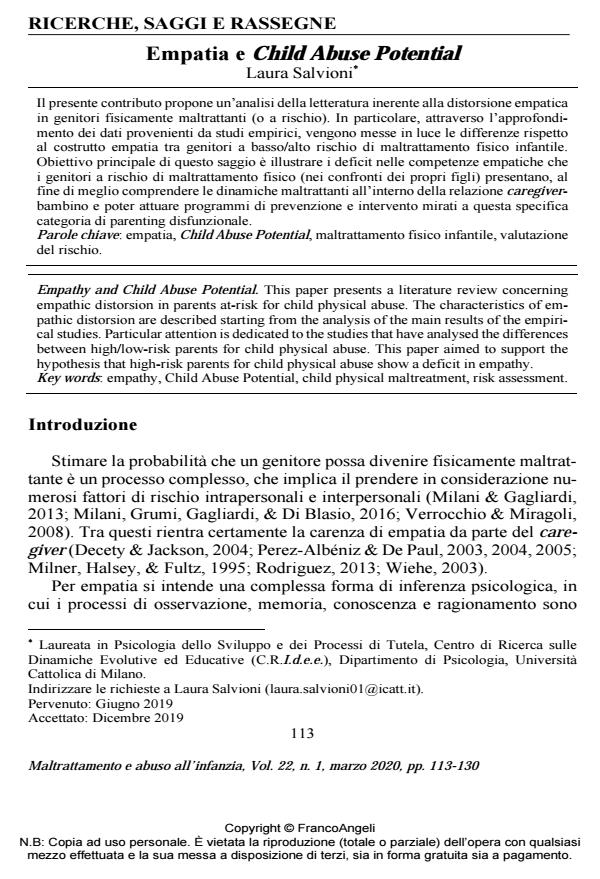Empatia e Child Abuse Potential
Titolo Rivista MALTRATTAMENTO E ABUSO ALL’INFANZIA
Autori/Curatori Laura Salvioni
Anno di pubblicazione 2020 Fascicolo 2020/1
Lingua Italiano Numero pagine 18 P. 113-130 Dimensione file 214 KB
DOI 10.3280/MAL2020-001008
Il DOI è il codice a barre della proprietà intellettuale: per saperne di più
clicca qui
Qui sotto puoi vedere in anteprima la prima pagina di questo articolo.
Se questo articolo ti interessa, lo puoi acquistare (e scaricare in formato pdf) seguendo le facili indicazioni per acquistare il download credit. Acquista Download Credits per scaricare questo Articolo in formato PDF

FrancoAngeli è membro della Publishers International Linking Association, Inc (PILA)associazione indipendente e non profit per facilitare (attraverso i servizi tecnologici implementati da CrossRef.org) l’accesso degli studiosi ai contenuti digitali nelle pubblicazioni professionali e scientifiche
Il presente contributo propone un’analisi della letteratura inerente alla distorsione empatica in genitori fisicamente maltrattanti (o a rischio). In particolare, attraverso l’approfondimento dei dati provenienti da studi empirici, vengono messe in luce le differenze rispetto al costrutto empatia tra genitori a basso/alto rischio di maltrattamento fisico infantile. Obiettivo principale di questo saggio è illustrare i deficit nelle competenze empatiche che i genitori a rischio di maltrattamento fisico (nei confronti dei propri figli) presentano, al fine di meglio comprendere le dinamiche maltrattanti all’interno della relazione caregiver-bambino e poter attuare programmi di prevenzione e intervento mirati a questa specifica categoria di parenting disfunzionale.
Parole chiave:Empatia, Child Abuse Potential, maltrattamento fisico infantile, valutazione del rischio.
- Nurse Home Visitation Program per la riduzione del rischio di maltrattamento infantile: una prima valutazione dell'intervento dell'Unità Funzionale Complessa Salute Mentale Infanzia e Adolescenza e Centri Consulenza Giovani dell'Azienda Usl Toscana Centro-Firenze Ludovica Di Paola, Annalaura Nocentini, Patricia Monica Bettini, Roberto Leonetti, in MALTRATTAMENTO E ABUSO ALL'INFANZIA 3/2021 pp.89
DOI: 10.3280/MAL2020-003008
Laura Salvioni, Empatia e Child Abuse Potential in "MALTRATTAMENTO E ABUSO ALL’INFANZIA" 1/2020, pp 113-130, DOI: 10.3280/MAL2020-001008